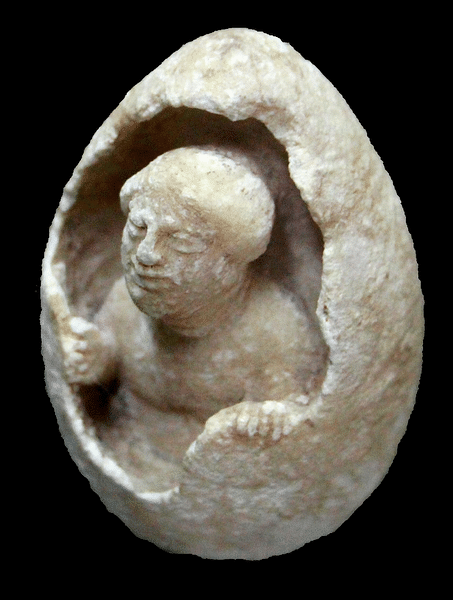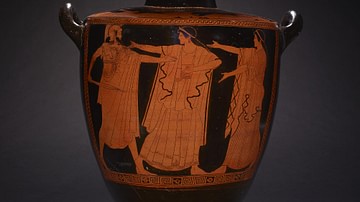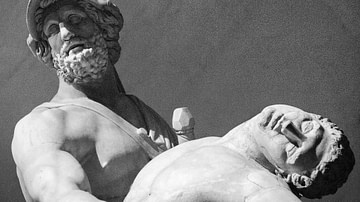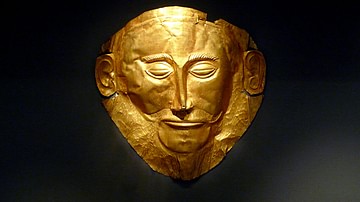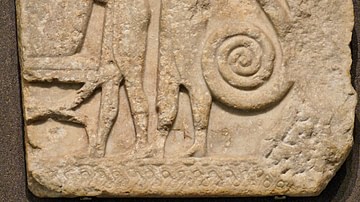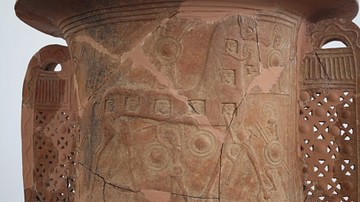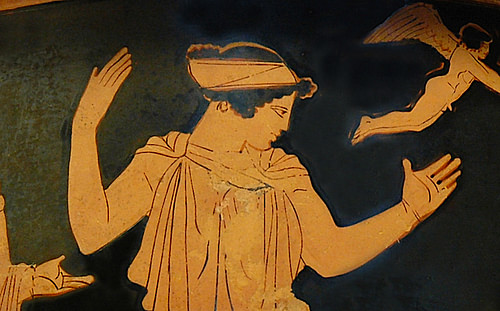
Helen of Troy (sometimes called Helen of Sparta) is a figure from Greek mythology whose elopement with (or abduction by) the Trojan prince Paris sparked off the Trojan War. Helen was the wife of Menelaus, the king of Sparta, and considered the most beautiful woman in the world.
Menelaus persuaded his brother Agamemnon, king of Mycenae, to form a great army to besiege the mighty city of Troy in order to recapture Helen. Following the Greek victory in the war, Helen returned home with Menelaus but she became a despised figure in the ancient world, a symbol of moral failure and the perils of placing lust above reason. Despite the poor standing of the literary Helen, she also had a divine form and was the centre of cults at several Greek sites, notably Rhodes, Sparta, and Therapne.
Family Relations
In Greek mythology, Helen was the daughter of Zeus and Leda, the queen of Sparta and the wife of Tyndareus. Zeus disguised himself as a swan to seduce Leda, and Helen was the result of their amorous engagement. In another version of the myth, Helen's mother is the goddess Nemesis, the personification of retribution. Whoever is the mother, in both versions, Helen is born from an egg in Sparta. Helen's siblings included the hero twins Castor and Pollux (aka Polydeuces) and Clytemnestra, the future wife of King Agamemnon, the king of Mycenae. One day, Tyndareus offered sacrifices to all the gods but forgot Aphrodite and the goddess, angered at the slight, then promised that all of the king's daughters would become infamous for their adultery.
Helen had many famous suitors but she would marry Agamemnon's brother Menelaus, king of Sparta. As part of the marriage deal, Tyndareus sacrificed a horse and made all the Greek leaders swear to recognise Helen as Menelaus' rightful wife and to protect his daughter from harm. This oath would have serious consequences when the time came for war. Menelaus and Helen had one daughter, Hermione, and three sons: Pleisthenes, Aethiolas, and Maraphius.
Helen was widely considered the most beautiful of all mortal women. In his Works and Days, Hesiod describes her as "fair-haired Helen" (165). Homer repeatedly describes her in his works as "Helen of the lovely hair" (Odyssey,15:58), "white-armed Helen" (Iliad, 3:119) and "Helen, queen among women" (Iliad, 3:422). Homer also describes her as "hateful Helen" (Iliad, 19:324).
Abduction by Theseus
Theseus, the legendary Athenian hero and early king of that city, captured Helen when she was a child and gave her to his mother to look after until she reached womanhood. The girl, who we are told was fond of wrestling and hunting, was then rescued by her brothers, the Dioscuri. The latter invaded Attica for the purpose, and Theseus was forced to flee to the Aegean island of Skyros. It seems that for Helen, even at a young age, her great beauty was something of a curse.
The Judgement of Paris
For the Greeks, the origins of the Trojan War went back to one particular event. At the wedding of Peleus and Thetis, Eris, the goddess of strife, offered a golden apple to the most beautiful of the goddesses of Olympia. Zeus invited the handsome Trojan prince Paris (also called Alexandros) to be the judge and decide between three choices: Athena, Hera, or Aphrodite. Paris was offered inducements from all three candidates: Athena promised him strength, beauty, and invincibility in battle; Hera offered the regions of Asia and immense wealth; and Aphrodite offered the most beautiful woman in the world: Helen. Paris chose Aphrodite, and he was able to grab his prize when he went on a diplomatic mission for the Trojans and became a guest in the house of Menelaus. The pair fell in love and eloped to Troy (aka Ilium) so that Helen of Sparta now became Helen of Troy. Helen, although she abandoned her children, was accompanied by her faithful servant Aithra. On the way home, Paris stopped in Sidon in Phoenicia and stole a hoard of treasure, which he took back to Troy.
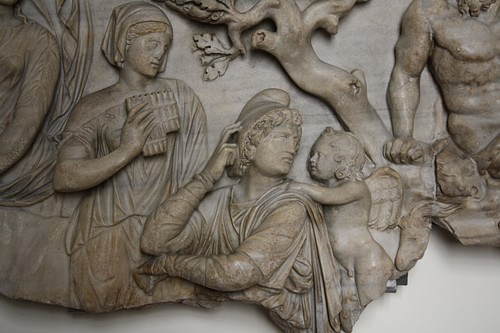
The 5th-century BCE Greek historian Herodotus tells a different version of these events in his Histories (2.113). Here Herodotus claims that Egyptians had told him personally that Paris and Helen had met unfavourable winds and so had sailed for Egypt, not Troy. On landing, Paris' men abandoned the eloping couple and denounced them to the local priesthood. They did this because Paris had abducted Helen when he was a guest at the home of Menelaus, an illegal and impious act in Greek culture. Further, Paris had taken with him a load of Spartan loot. Proteus, the ruler of Memphis, is informed, and he arrests Paris and keeps both the loot and Helen to give back to the Greeks at some future date. Herodotus even states that other writers like Homer (see below) knew this version but decided on a more epic and entertaining story involving the city of Troy and a long war. However, there is common ground in both versions since Herodotus goes on to say that the Greek fleet in pursuit of Helen made contact with the Egyptians but simply did not believe she had not been taken to Troy and so they besieged that city anyway. When they found out she had been in Egypt all the time, Menelaus sailed to Memphis and got his wife back. In addition to all of these details, Herodotus claims that a temple dedicated to a 'Foreign Aphrodite' at Memphis was, in fact, built in honour of Helen.
Whatever the details of how or if Helen ever got to Troy, whether she went of her own free will or was abducted is a difficult question to resolve. That Helen was a willing lover of Paris is seen in Archaic Attic pottery scenes, but in others, Paris grabs her arm (and not her hand). Yet other pottery scenes show Menelaus brandishing a sword as he reclaims Helen, suggesting she was unwilling to return to her husband. Then again, alternative scenes show Menelaus dropping his sword, seemingly in forgiveness, when he meets Helen again.
Whatever the ambiguity in art and literature, in a familiar negative attitude to women ranging from Pandora to Medea, most Greeks considered Helen shameless. As the historian Barbara Graziosi notes, "Nobody in the ancient world thought that it was all right for a real-life woman to behave like Helen" (59) even if Aphrodite goddess of love, Ares god of war, and Paris were all considered as much to blame as anyone for the tragic consequences of the Trojan War.

The Trojan War
The main source for our knowledge of the Trojan War and the most popular version of the story is presented by Homer in his Iliad, an epic poem written sometime in the 8th century BCE, and which was based on older oral legends. According to this version, a massive army of many Greek states sailed for Troy and laid siege to the city until Helen was recovered. The Greeks imagined this war to have occurred sometime in the 13th century BCE, what we today would call the Aegean Bronze Age. A conflict between Mycenaeans and Hittites may well have occurred and archaeologists are mostly in agreement that the great city with impressive defensive walls which has been excavated in modern-day Turkey is indeed Troy. The city has many layers of history and what archaeologists call Troy VI, which dates to c. 1750-1300 BCE, is regarded as the most likely candidate for Homer and Helen's Troy. A war over trade, resources, and colonies seems quite likely, though not on the scale of the epic Trojan War. Even in mythology, Agamemnon is motivated to lead the Greek army not only to save his brother's honour but to acquire immense riches.
According to the story, the Trojan War lasted 10 years and took place at the city of Troy in Anatolia. Troy had massive walls and so the war was mostly a siege with some breaks for open warfare on the plains outside the city. Priam, the king of Troy, and his son Hector, both treat Helen respectfully during the conflict, with Hector, in particular, blaming Paris as the bringer of war. In this period, Paris and Helen have four children, three sons: Bunomus, Aganus, and Idaeus, and one daughter: Helen. All three boys will die when a roof collapses in the chaos at the end of the war.
One of the many memorable episodes of the war is when Menelaus battles Paris in a one-on-one fight, with the victor promised Helen. Menelaus gets the better of the Trojan prince but he is saved by Aphrodite and whisked from the battlefield back to the safety of his chambers. The Greeks do finally win the conflict through the ruse of the Trojan Horse, a massive wooden idol inside of which were hidden Greek warriors who get inside the city and open the gates for the rest of the Greek army to follow. The Trojans were either all slaughtered or enslaved, a brutal reminder in myth of the folly of adultery. Paris is killed by an arrow fired by Philoctetes. Menelaus, meanwhile, is reunited with Helen. 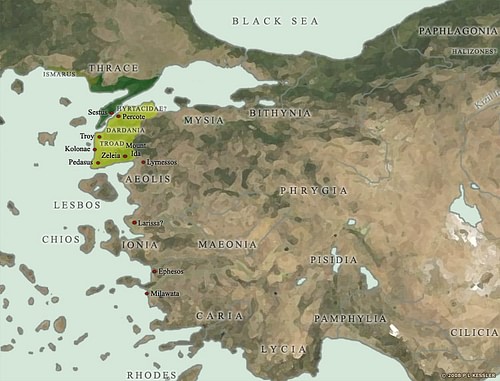
According to some versions of the story, the Spartan king first draws his sword and intends to strike down Helen before seeing her naked breasts, having a rethink and then embracing her. In one Greek play, Menelaus is portrayed as a rather dim chap who is now only concerned his wife has not put on any weight during the long siege. Whatever the version, it is a case of 'forgive and forget'.
The Return Home
Menelaus and Helen return to Greece, stopping off at various places along the way. These events are told by Homer, this time in his Odyssey. First, the couple is dashed against the rocks of Crete in a storm. Next, arriving in Egypt, the couple spends many years there. Unable to gain favourable winds to get home, Menelaus makes trips to Cyprus and then the city of Sidon in Phoenicia, land of fine textiles and silverware, some of which the Spartan receives as souvenirs. Next is North Africa (Libya), which is described as a bountiful land, and then a trip to Ethiopia as Menelaus' treasure trove grows. Homer also has Menelaus meet Proteus in Egypt, who is here not a ruler but the sea god better known as the 'Old Man of the Sea'. These Mediterranean detours (and those of Paris on his return voyage to Troy) may well be a mythological explanation for the Bronze Age trade between Mycenaean Greece, Phoenicia, and Egypt, explaining, too, the transferral of ideas in art and pottery.
Helen and Menelaus do finally get favourable winds and make it back to Sparta. They reunite with their daughter Hermione who marries Orestes, the son of Agamemnon. This explains how a single king came to rule both Mycenae and Sparta.
The Cult of Helen
Rather at odds with her standing in Greek literature, Helen was worshipped as divine at certain Greek sites. Scholars are broadly in agreement that Helen must first have been a goddess and then a semi-divine human figure. It may be that the myths of her abductions were an explanation of the goddess' temporary absences from her cult sites.
Rhodes and Attica had cults to Helen. It was at Sparta, however, that she was most popular as a religious figure, seen as a symbol of the transition from adolescent to bride (parthenos to nymphê). Helen also represented the adult married woman (gynê) and the figure of a sister (adelphê). At Rhodes, Helen was associated with fertility, trees, and vegetation, while at Sparta she represented the aspects of erotic desire and beauty which Aphrodite similarly represented.
One of the oldest sanctuaries dedicated to Helen was at Therapne, near Sparta. There she represented the adult married woman, and the site had a temple where offerings were made in Helen's name so that she would bestow alluring qualities on the faithful. Herodotus records in his Histories (6.61) that the third wife of King Ariston was miraculously changed from a state of great ugliness to a raving beauty thanks to the divine intervention of Helen at Therapne. According to the 2nd-century CE Greek historian and geographer Pausanias in his Description of Greece (3.19.9), locals believed that Menelaus and Helen were buried at Therapne. Their tomb was built c. 700 BCE near a 15th-century BCE Mycenaean 'palace' and consisted of a large rectangle of ashlar blocks with a small temple, all set on a mound and approached by a ramp. Excavations have revealed the site received dedicatory offerings to the pair and was in use until the 1st century BCE.
Helen in Art & Literature
Helen and the Trojan War were very popular subjects in many other examples of Classical literature besides Homer. For example, she is featured in Aeschylus' Agamemnon and Virgil's Aeneid. In the 5th-century BCE tragedian Euripides' Trojan Women, Helen appears in a trial before the captured women of Troy and defends her behaviour. Helen's chief defence against the charge of adultery is that she had become a plaything of the gods and so could not avoid her fate. In contrast, in Euripides' play Helen, the queen never reaches Troy but, as in Herodotus' version, she remains all the while in Egypt. The sophist Gorgias (c. 485 - c. 380 BCE) presented a humorous defence of Helen, but this was most likely an exercise in rhetoric rather than any attempt to set the historical record straight.
In the visual arts, Helen emerging from an egg appears on red-figure pottery from Apulia and Campania during the 4th century BCE. Helen's abduction by Theseus appears on Attic red-figure pottery of the Archaic period. She often appears in both red-figure and black-figure pottery scenes of the Classical period being led away by Paris, in domestic scenes, and being pursued by or reconciled with Menelaus.
Right through antiquity and for centuries after, the story of Helen continued to fascinate, especially in the Renaissance period when she appears in a wide range of genres from the paintings of Tintoretto (c. 1518-1594 CE) to the poems of Christopher Marlowe (1564-1593 CE). It was Marlowe who penned the lines by which Helen is most-remembered today:
The face that launched a thousand ships
And burnt the topless towers of Ilium.
(The Tragical History of Doctor Faustus, quoted in Hope Moncrieff, 230)
